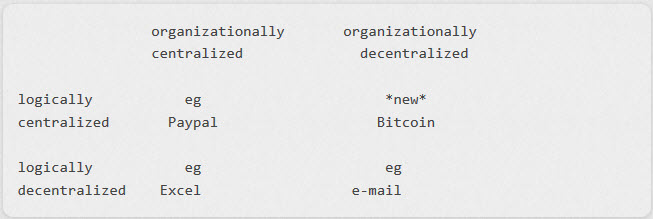There is a confusion about Bitcoin that trips up a lots of people when they first learn about it: the blockchain is organizationally decentralized but logically centralized! What does this mean? Here is a 2 x 2 matrix that should help:

The “organizationally centralized” column on the left contains systems that are controlled by a single organization (EBay and Microsoft in the examples, but this doesn’t need to be a corporation, it could also be a government). Conversely the “organizationally decentralized” column on the right contains systems that are not under the control of any one entity whether for profit or otherwise.
The “logically decentralized” row at the bottom contains systems that have multiple databases and in which participant controls their own database entirely. For instance, when you send me an Excel file and I now work on that on my machine I only make changes to my copy. You and I can work on entirely different Excel files without them ever being connected to each other. Even with email we each control our separate databases. For instance, I can delete a message that you sent me and that doesn’t delete it in your “sent” box.
Conversely the “logically centralized” row on top contains systems that appear as if they have a single global database. I say “appear” because technologically there could be many separate database systems involved. What “logically centralized” means is simply that anyone in the world gets the same answer when querying the system.
The important innovation provided by the blockchain is that it makes the top right quadrant possible. We already had the top left. Paypal for instance maintains a logically centralized database for its payments infrastructure. When I pay someone on Paypal their account is credited and mine is debited. But up until now all such systems had to be controlled by a single organization.
Let me repeat that again for emphasis: before the blockchain’s existence there were *no* systems that were organizationally decentralized, yet logically centralized. This is why Bitcoin is such a foundational technology. When I send Bitcoin to someone then both the debit and the credit are recorded in the blockchain even though that database is not controlled by one organization. As it turns out, this means that many other applications that require a single global database can now be created on top of the Blockchain Application Stack.
Source: Bitcoin: Clarifying the Foundational Innovation of the Blockchain
